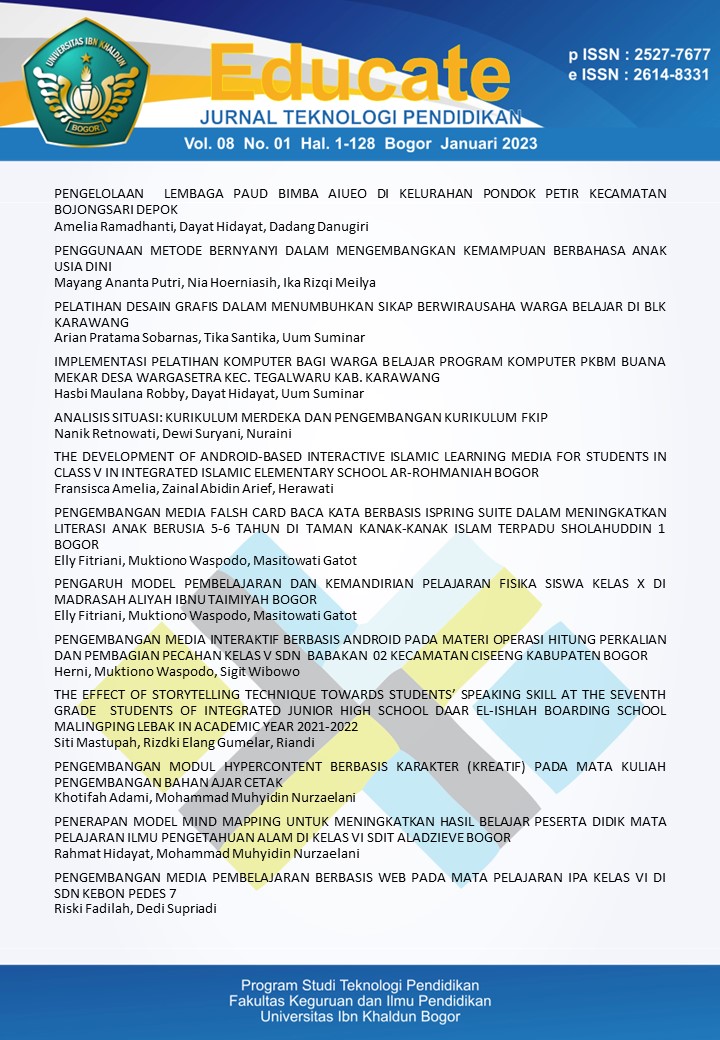The Development Of Android-Based Interactive Islamic Learning Media For Students In Class V In Integrated Islamic Elementary School Ar-Rohmaniah Bogor
DOI:
https://doi.org/10.32832/educate.v8i1.8275Kata Kunci:
Interactive Learning Media, AndroidAbstrak
This type of research is research and development (Reserch and Development) which aims to analyze: (1) the process of developing interactive media for learning android-based Islamic religious education based on the Borg and Gall model for fifth grade students at SDIT Ar-Rohmaniyah Bogor, (2) media feasibility interactive learning of android-based Islamic religious education based on the Borg and Gall model for fifth grade students at SDIT Ar-Rohmaniyah Bogor, (3) the effectiveness of interactive media for learning android-based Islamic religious education based on the Borg and Gall model for fifth grade students at SDIT Ar-Rohmaniyah Bogor.
The method used in this research is research and development (Reserch and Development) based on the Borg and Gall model. The validators consist of one material expert, one media and instructional design expert, one learning practitioner (PAI teacher), students for individual trials, 10 students for small group trials and thirty students for trials. field. The method of data collection used is a questionnaire. The data analysis technique used is qualitative and quantitative analysis.
The conclusions of this study are that: (1) the process of developing interactive media for learning Islamic religious education based on Android based on the Borg and Gall model for fifth grade students at SDIT Ar-Rohmaniyah Bogor with the procedures of 1) research and information collecting, 2) planning, 3) develop preliminary form of product, 4) preliminary field testing, 5) main product revision, 6) Main field testing, 7) operational product revision, 8) operational field testing, 9) final product revision, and 10) dissemination and implementation. (2) the assessment of the feasibility of interactive learning media by material experts obtained a score of 98.6% in the "Very Eligible" category. The feasibility assessment by media and instructional design experts obtained a score of 98.2% in the "Very Eligible” category. The feasibility value by learning practitioners (PAI teachers) obtained a score of 94.8% in the "Very Eligible" category. The average rating from the expert was 97.2% in the "Very Eligible” category. The response from students in this interactive learning media in individual trials is worth 96.6, in small group trials, values are obtained and in field trials, the average value of this application is 97.2, thus the interactive learning media for Android-based Islamic religious education is said to be very good. appropriate and good for fifth grade students of SDIT Ar-Rohmaniyah Bogor. The effectiveness of the media is seen from the results of the pre-test and post-test, namely the average N-Gain value students by 0.82. Based on these data, it can be concluded that the Android-based learning of Islamic religious education for fifth grade students of SDIT Ar-Rohmaniyah Bogor is in the High N-Gain category. Based on the N-Gain interpretation table, the Android-based Islamic religious education learning activities for class V SDIT Ar-Rohmaniyah Bogor are effectiveReferensi
Borg, W.R. & Gall, M.D. Gall. (1989). Educational Research: An Introduction,Fifth Edition. New York: Longman.
Dick & carey, lou. 2005. The System Design of Instruction, 6 ed . New York: Longman, 2005
Sugiyono. 2009. Metode Penelitian Pendidikan Pendekatan Kuantitatif,
Kualitatif, dan R & D. Bandung : Alfabeta.
Safaat, Nazruddin. 2012. Pemrograman Aplikasi Mobile Smartphone and Tablet PC. Bandung: Informatika.
Swajati. 2005. Belajar Sendiri: Membuat CD-Multimedia Interaktif untuk
Bahan Ajar E-Learning. Jakarta: PT Elek Media Komputindo.
Syaodih, Nana. 2009. Landasan Psikologi Proses Pendidikan. Bandung: PT Remaja Rosdakarya.
Unduhan
Diterbitkan
Cara Mengutip
Terbitan
Bagian
Lisensi
| Authors grant the journal copyright of the work licensed under CC-BY-SA or The Creative Commons Attribution–ShareAlike License that allows others to share the work with an acknowledgement of the work's authorship and initial publication in this journal. | Penulis memberikan hak cipta karyanya kepada jurnal yang dilisensikan dengan CC-BY-SA or The Creative Commons Attribution–ShareAlike License yang memungkinkan orang lain untuk menggunakan karya dengan pengakuan kepengarangan karya dan publikasi awal dalam jurnal ini. |









